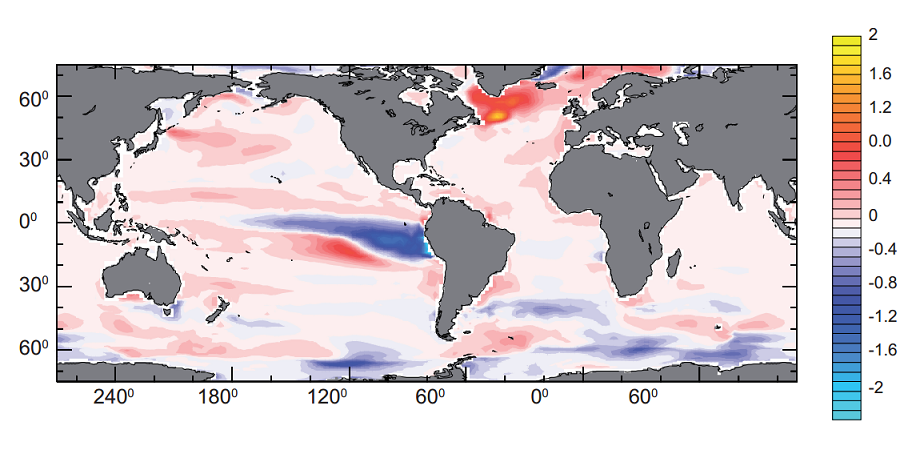Difference between revisions of "Green Ocean modelling"
| Line 26: | Line 26: | ||
| − | [[Image: | + | [[Image:SouzaDias.0307.greenoceanFIG2.PNG |center|'''Figure 2''' Change in the oceanic sink for CO2 (mol/m<sup>2</sup>/y) caused by shifts in ecosystem composition projected for year 2060 and estimated with a Dynamic Green Ocean Model which includes 5 Plankton Functional Types. A model with 10 Plankton Functional Types is currently under development. Negative values denote net flux of CO2 from atmosphere to seawater, and positive values indicate reduced CO2 flux into seawater.|frame]] |
Revision as of 12:36, 3 July 2012
Contents
a tool to understand the interactions between marine ecosystems and climate
Background
The Earth’s climate is changing. Indeed warmer temperatures, changes in precipitation, ice cover, river fluxes and atmospheric dust deposition have all been observed in recent decades. In addition, the ocean surface has become more acidic due to the absorption of increased atmospheric carbon dioxide (CO2). How do these changes impact marine ecosystems? To answer this we need better models capable of capturing the dynamics of marine ecosystems, and adequate and continued ocean observation programmes.
Why is ecosystem dynamics so important for interpreting climate change impacts?
Firstly, because of the nature of food webs in the ocean. Phytoplankton, the smallest marine organisms, transform energy from the sun into organic tissue. Phytoplankton are eaten by zooplankton, which are eaten by small fish, and these by bigger fish and so on. Changes in the abundance, type and distribution of phyto- and zoo-plankton result in complex impacts on the distribution and production of fish populations.
Secondly, because marine ecosystems have an influence on the composition of gases in the atmosphere. Indeed, the production and sinking of organic particles in the oceans helps regulate the concentration of the main greenhouse gas, CO2. Without the action of marine ecosystems atmospheric CO2 would be 1.5 times higher than it is today. Any changes in marine ecosystems could have an impact on atmospheric CO2. Marine ecosystems also emit other greenhouse gases and DMS (dimethyl sulfide), which has a cooling effect on climate.
What is Green Ocean Modelling?
Dynamic Green Ocean Models are mathematical representations of the ocean which include ocean currents, chemical processes and a representation of marine ecosystems that is based on the concept of Plankton Functional Types (PFTs). Plankton both responds to, and influences climate. In order to quantify and understand the interactions between marine ecosystems and climate, phyto- and zoo- plankton communities are simplified in the model into PFTs according to their size and functional role (Figure 1).
Template
We use observations to describe the dynamics of the various PFTs. Observations include laboratory work or physiological studies under controlled laboratory conditions, where the concentrations of nutrients or the water acidity are manipulated and the response of the ecosystem or its parts is monitored. These experiments allow us to quantify the growth and mortality of the PFTs.
Some PFTs share common characteristics such as growth rates, survival strategies, and the response to temperature and light. Zooplankton PFTs typically eat prey 2 to 10 times smaller than themselves, and produce fecal pellets that sink and transport carbon and nutrients to the deep ocean. Finally, observations that give a large-scale picture of the abundance and distribution of each PFT are used to evaluate whether the representation of the ecosystem in the models is accurate and if the model reproduces the basic features such as the seasonal cycle of the PFTs. When the observations and models have been put together and evaluated, the resulting Dynamic Green Ocean Model can be used to estimate how ecosystems respond to different climatic conditions and if this response could affect food production or cause dangerous feedbacks on the climate.
What do Green Ocean Models tell us?
Dynamic Green Ocean Models are powerful tools capable of resolving and predicting the functioning of marine ecosystems based on actual or theoretical climate change scenarios. Preliminary model results are already available and indicate large shifts in ecosystem composition triggered by the changing climate conditions. These model results also show local modifications in the fluxes of CO2 between the atmosphere and seawater as a result of changes in ecosystem composition (Figure 2.). Dynamic Green Ocean Models are specifically designed to estimate the impact that changes in ecosystem composition may have on the climate.

